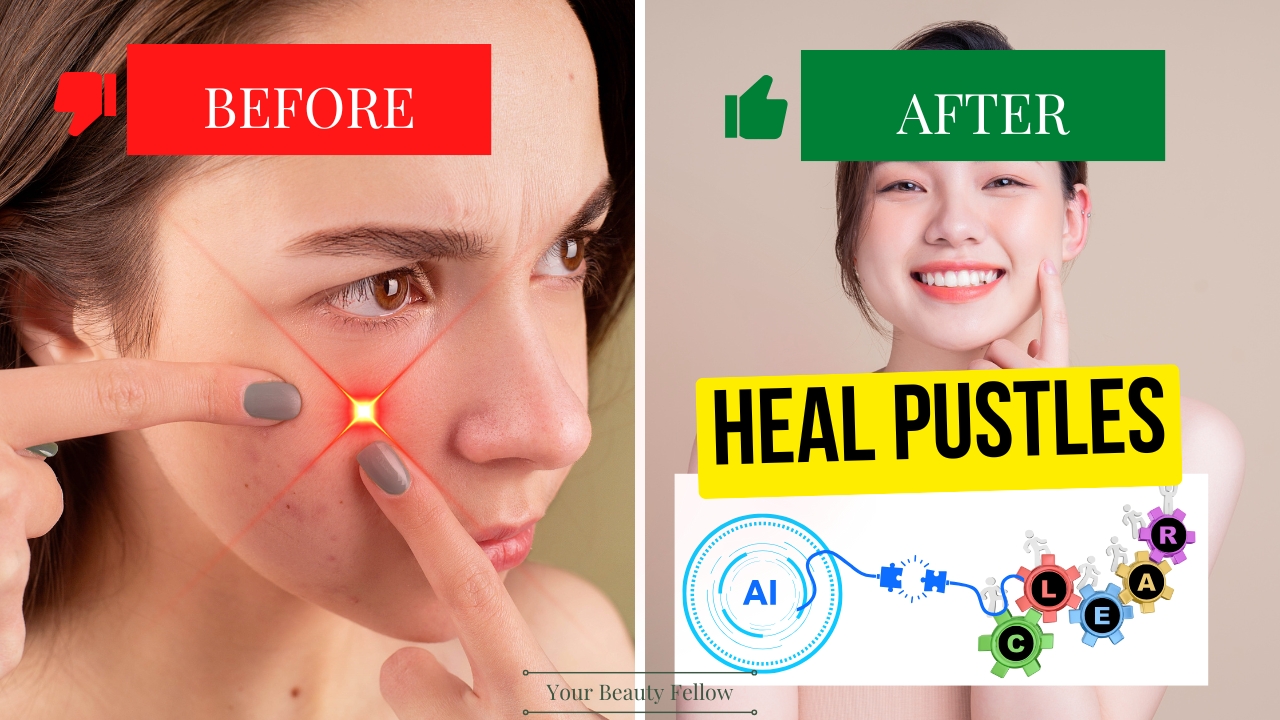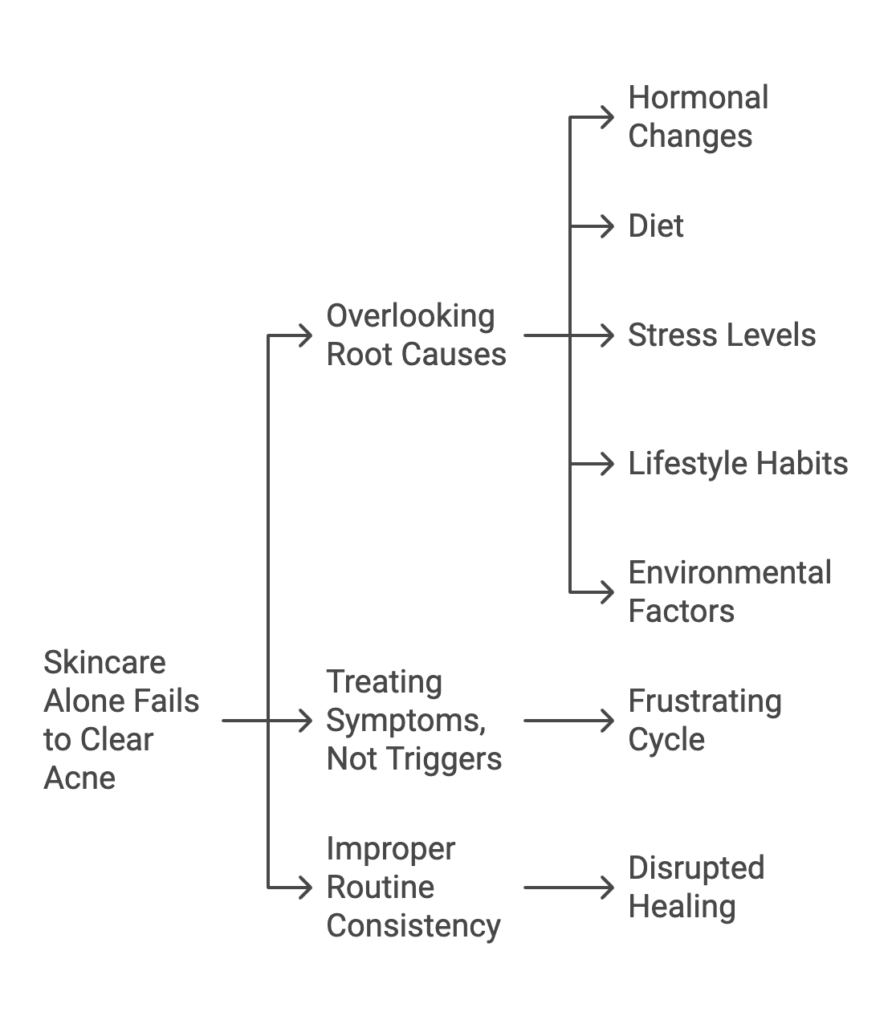
Pustules are the next stage of acne, often appearing as inflamed, pus-filled pimples that can feel tender and frustrating. Unlike blackheads and papules, pustules are more noticeable, making people eager to heal them quickly—sometimes turning to home remedies for fast relief. While some remedies can help, addressing acne pustules effectively requires proper identification, targeted treatments, and a systematic approach.
At this stage, it’s common to deal with multiple types of acne—including blackheads, papules, whiteheads, pustules, and even scars. This can make managing your skin overwhelming, especially when browsing forums like Reddit, where personal experiences often lack the nuance to apply to your unique skin.
This article will guide you step-by-step on how to recognise, treat, and prevent acne pustules effectively. By combining the systematic CLEAR Skin Framework and advanced AI tools, you’ll gain professional, practical solutions for achieving clearer, healthier skin.
What Are Pustules, and How Are They Different from Papules?
Pustules are inflamed pimples filled with white or yellow pus. They’re often surrounded by red, irritated skin and can vary in size. While papules are solid, red bumps without a pus-filled center, pustules result when the body’s immune response fights off acne-causing bacteria trapped in clogged pores.
Key Signs of Acne Pustules:
- White or yellow pus-filled center.
- Red, inflamed skin around the lesion.
- Tender or slightly painful to touch.
Pustules Can Also Be Caused By:
- Psoriasis: Pustules in this condition are non-acne-related and require specialised treatment.
- Rosacea: Acne-like pustules can appear during flare-ups.
- Infections: Bacterial or fungal infections may also cause pustules.
Using AI skin analysis tools can help identify whether your pustules are acne-related or caused by another condition, ensuring you use the right treatments.
Why Skincare Alone Often Fails to Heal Pustules
Many people who diligently follow skincare routines with effective active ingredients still experience persistent acne. Why does this happen? The problem often lies in addressing symptoms without targeting the underlying causes.

Key reasons skincare alone fails:
• Overlooking Root Causes: Acne isn’t just a skin issue—it is influenced by hormonal changes, diet, stress levels, lifestyle habits, and even environmental factors. For instance, an imbalance in hormones during puberty or due to stress can trigger excess oil production, leading to pustules.
• Treating Symptoms, Not Triggers: Using skincare products without understanding the cause of your breakouts might clear existing pustules, but new ones may continue to appear, creating a frustrating cycle.
• Improper Routine Consistency: Inconsistent use of skincare products or switching routines too often can disrupt your skin’s healing process.
To truly clear pustules, you need a holistic approach that combines skincare with lifestyle adjustments and professional insights into your skin’s unique needs.
Treating and Preventing Pustules with AI Tools and the CLEAR Skin Framework
Let’s break down a professional, systematic plan to manage pustules effectively:

1. Classify Your Skin Type
Your skin type—whether oily, dry, combination, or sensitive—dictates the best treatment approach. Oily skin may need more oil-control ingredients like salicylic acid, while sensitive skin may require gentler actives like niacinamide.
AI skin scanners can analyse your skin type and suggest customised product recommendations, saving you from overwhelming trial-and-error.
2. Learn Your Skin Needs
Each skin type reacts differently to skincare products. AI tools can also analyse ingredient lists, flagging what works best for you. At this stage, your skin likely needs:
- Bacteria Control: Ingredients like benzoyl peroxide or tea tree oil combat acne-causing bacteria.
- Anti-Inflammation: Niacinamide or azelaic acid to calm redness.
- Exfoliation: Salicylic acid unclogs pores and prevents new pustules.
- Moisture Barrier Support: Hydrating ingredients like ceramides and hyaluronic acid prevent irritation from acne treatments.
AI tools can help you select the right concentrations and combinations of these ingredients for your specific skin concerns.
3. Establish SMART Skin Goals
Set Specific, Measurable, Achievable, Relevant, and Time-bound (SMART) goals to track your progress.
Realistic Timeline: Healing pustules typically takes 6-8 weeks, depending on severity. Aim for gradual improvement instead of expecting overnight results. For example:
- Week 1-2: Reduce inflammation and prevent new pustules.
- Week 3-4: Begin lightening post-inflammatory marks.
- Week 5-8: Focus on maintaining clear skin and refining texture.
AI apps can track your progress with weekly skin scans and help you stay consistent with your routine.
4. Assemble a Personalised Skincare Routine
Build a skincare routine that addresses pustules holistically:
Daily Routine
Morning:
1. Gentle cleanser with salicylic acid.
2. Niacinamide serum for inflammation.
3. Non-comedogenic moisturiser.
4. Broad-spectrum sunscreen (SPF 30+).
Evening:
1. Double cleanse if wearing makeup or sunscreen.
2. Spot treatment with benzoyl peroxide or adapalene.
3. Lightweight moisturiser to prevent dryness.
Weekly Treatment Plan
- 1-2 Times Weekly: Use a clay mask or sulfur-based mask to unclog pores and reduce excess oil.
- Once Weekly: Gentle exfoliation with a chemical exfoliant (like glycolic or lactic acid) to promote skin renewal.
5. Review and Track Your Progress
AI tools can help you monitor your skin’s progress, identifying what’s working and what isn’t. Track changes in redness, size, and frequency of pustules to fine-tune your routine.
Home Remedies for Soothing Pustules
While home remedies alone won’t replace a targeted routine, they can support healing:
1. Warm Compress: Apply a clean, warm compress to pustules for 5-10 minutes to reduce swelling.
2. Spot Treatment with Tea Tree Oil: Use a diluted solution (5% concentration) to combat bacteria.
3. Aloe Vera Gel: Apply as a soothing moisturiser to calm redness.
Preventing and Stopping Acne Pustules from Recurring
First, prevention starts with addressing the root causes of all acne forms:
1. Clear Blackheads: Refer to our blackhead article for tips to clear clogged pores early.
2. Manage Papules: Reduce inflammation with targeted ingredients as explained in our papules article.
3. Stay Consistent: Follow your routine daily to prevent new breakouts.
Second, stop pustules from recurring:
1. Address Lifestyle Factors:
• Manage stress with relaxation techniques like yoga or meditation.
• Eat a balanced diet rich in anti-inflammatory foods (like fruits, vegetables, and omega-3s).
• Stay hydrated and prioritise sleep.
2. Keep Your Skin Clean:
• Avoid touching your face frequently.
• Change pillowcases and towels regularly to minimise bacteria.
3. Regular Skin Maintenance:
• Continue using a simple, consistent skincare routine to prevent buildup of oil and debris.
Holistic Healing: Combining Skincare and Root Cause Management

By now, you may be dealing with multiple types of acne, including blackheads, papules, and pustules. Here’s what to prioritise:
1. Tackle Active Acne: Focus first on healing pustules and calming inflammation.
2. Prevent New Breakouts: Use salicylic acid to keep pores clear.
3. Set Long-Term Goals: Gradually fade acne scars and maintain healthy skin.
To heal pustules effectively, you need more than just a good routine—you need to understand your skin at a deeper level. Combining lifestyle changes with personalised skincare and regular progress tracking ensures long-term results.
Better Skin, Better You
Healing pustules fast requires addressing both the symptoms and their root causes. By following the CLEAR Skin Framework and leveraging AI tools, you can create a personalised, systematic plan that promotes healing, prevents recurrence, and boosts your confidence.
Acne doesn’t define you—your journey to clear skin starts here. With the right knowledge and tools, achieving your skin goals is within reach.
Your skin reflects your confidence—let’s work together to help you become the best version of yourself.
Frequently Asked Questions
What’s the Difference Between a Pustule and a Papule in Acne?
A pustule is an inflamed pimple filled with white or yellow pus, typically surrounded by red, irritated skin and tender to touch. In contrast, a papule is a solid, red bump without a pus-filled centre. Pustules occur when the body’s immune response fights acne-causing bacteria trapped in clogged pores, making them more visually prominent and often more painful than papules.
Can AI Tools Really Help Me Manage My Acne Pustules?
AI skin analysis tools can help identify your specific skin type, analyse ingredient effectiveness, and track your skin’s progress. These advanced technologies provide personalised recommendations by scanning your skin, suggesting targeted treatments, and monitoring changes in pustule size, redness, and frequency. They transform skincare from a guessing game to a data-driven approach, helping you create a more effective, customised acne management strategy.
How Long Does It Typically Take to Heal Acne Pustules?
Healing acne pustules usually takes 6-8 weeks, depending on severity and consistency of treatment. The CLEAR Skin Framework suggests a phased approach: weeks 1-2 focus on reducing inflammation and preventing new pustules, weeks 3-4 target lightening post-inflammatory marks, and weeks 5-8 concentrate on maintaining clear skin and improving texture. Patience and a systematic routine are key to successful treatment.
Are Home Remedies Effective for Treating Pustules?
While home remedies alone can’t replace a targeted skincare routine, they can support healing. Effective home treatments include applying a warm compress for 5-10 minutes to reduce swelling, using diluted tea tree oil (5% concentration) as a spot treatment to combat bacteria, and applying soothing aloe vera gel to calm redness. However, these should complement, not replace, a comprehensive skincare approach.
What Lifestyle Factors Contribute to Acne Pustules?
Acne pustules are influenced by multiple lifestyle factors, including hormonal changes, diet, stress levels, and environmental conditions. Stress can trigger excess oil production, while an unbalanced diet might exacerbate inflammation. Key prevention strategies include managing stress through techniques like meditation, consuming anti-inflammatory foods, staying hydrated, prioritising sleep, avoiding face touching, and maintaining consistent skincare habits.
Can Pustules Be a Sign of Something More Serious?
While most pustules are acne-related, they can sometimes indicate other conditions like psoriasis, rosacea, or bacterial/fungal infections. If pustules are persistent, unusually painful, or accompanied by other symptoms, it’s crucial to consult a dermatologist. AI skin analysis tools can help initially identify whether pustules are likely acne-related, but professional medical advice is recommended for comprehensive evaluation.
How Do I Prevent Acne Pustules from Recurring?
Preventing pustule recurrence requires a holistic approach: clear blackheads early, manage inflammation, maintain a consistent skincare routine, and address root causes. Use salicylic acid to keep pores clear, implement a daily skincare regimen with bacteria-controlling and anti-inflammatory ingredients, manage stress, eat a balanced diet, stay hydrated, and avoid touching your face. Regular tracking and adaptability are key to long-term skin health.






